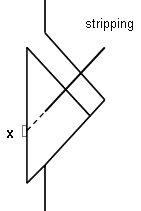Bolt Failure Modes
There are five bolt failure modes which can be reported in RocSlope2:
- Pullout
- Tensile
- Stripping
- Shear
- Compression
In the event that a bolt cannot be equated to any of the above modes, bolts can also be defined as any of the following:
- User-Defined
- Simple Force
- Unknown
The failure mode is also indicated when you display the Force Diagrams for the bolts. This can be done using the Force Diagram Visibility Toggle in the Results menu. The different modes will be color-coded when Show Bolt Force Diagrams is toggled ON, and a legend will be displayed to the right of the Results Grid.
Pullout / Tensile / Stripping
Pullout, Tensile, and Stripping are all tensile failure modes. They are determined by the Bolt Force Diagram and the point at which a block face intersects the bolt. For examples of bolt force diagrams, see the Force Diagram topic, and the topics for the individual Bolt Types in RocSlope2 (e.g., Mechanically Anchored, Cable Bolt, etc.).



Shear
The Shear failure mode will only be reported if:
- The Use Shear Capacity option is selected, for a given bolt type.
- The bolt intersects a sliding plane of a block (as opposed to a dilating plane).
See the Use Shear Capacity and Bolt Implementation topics for more information.

User-Defined
If a bolt failure mode is reported as User Defined, this simply means that the bolt (tensile) properties have been defined with a User-Defined bolt type (i.e., the user creates an explicit Bolt Force diagram, rather than entering various capacities). For more information, see the User-Defined Bolt topic.
Simple Force
If a bolt failure mode is reported as Simple Force, this simply means that the bolt (tensile) properties have been defined with the Simple Bolt Force type. For more information, see the Simple Bolt Force topic.
Compression
The Compression failure mode will only be reported under the following circumstances:
- The bolt intersects a sliding plane of a block, and the deformation mode of the bolt is mode F (as illustrated in the Bolt Implementation topic).
- Bolt Shear Strength ("Use Shear Capacity" checkbox) is OFF.